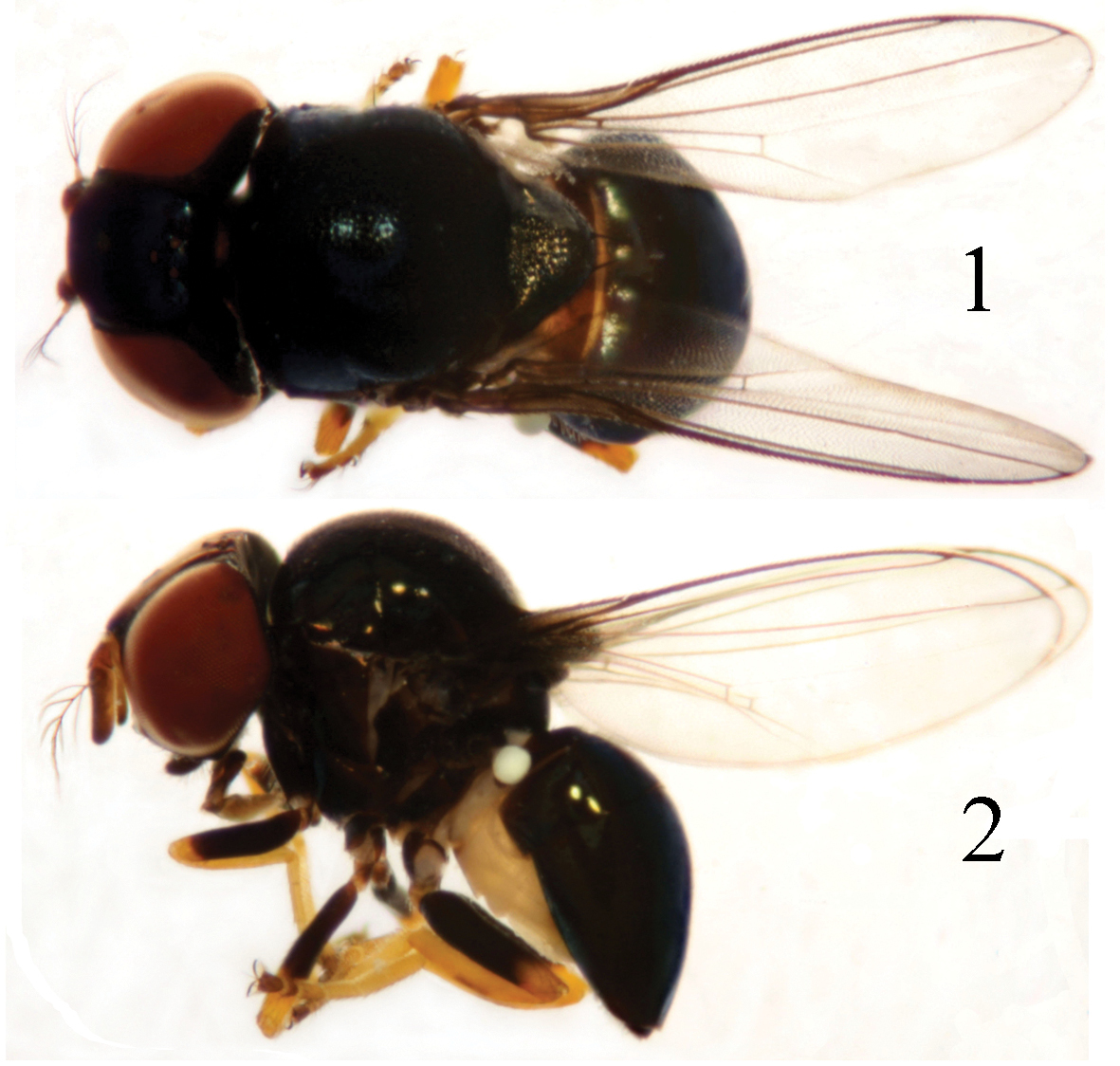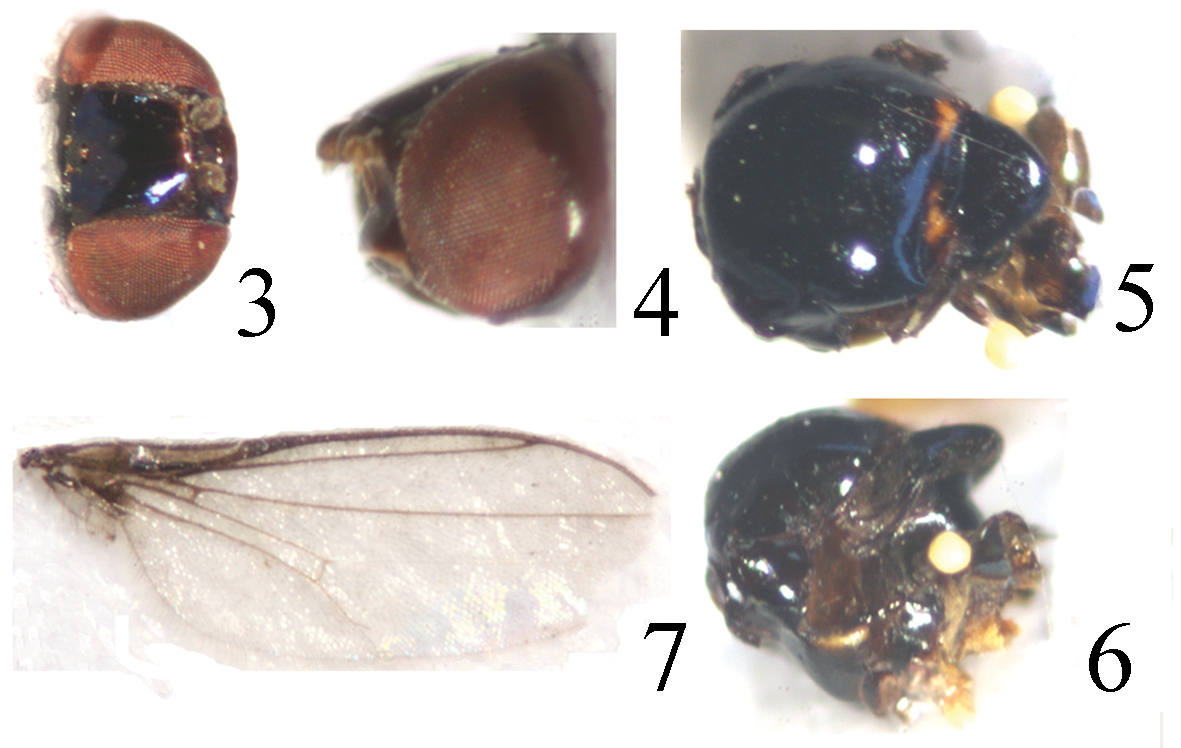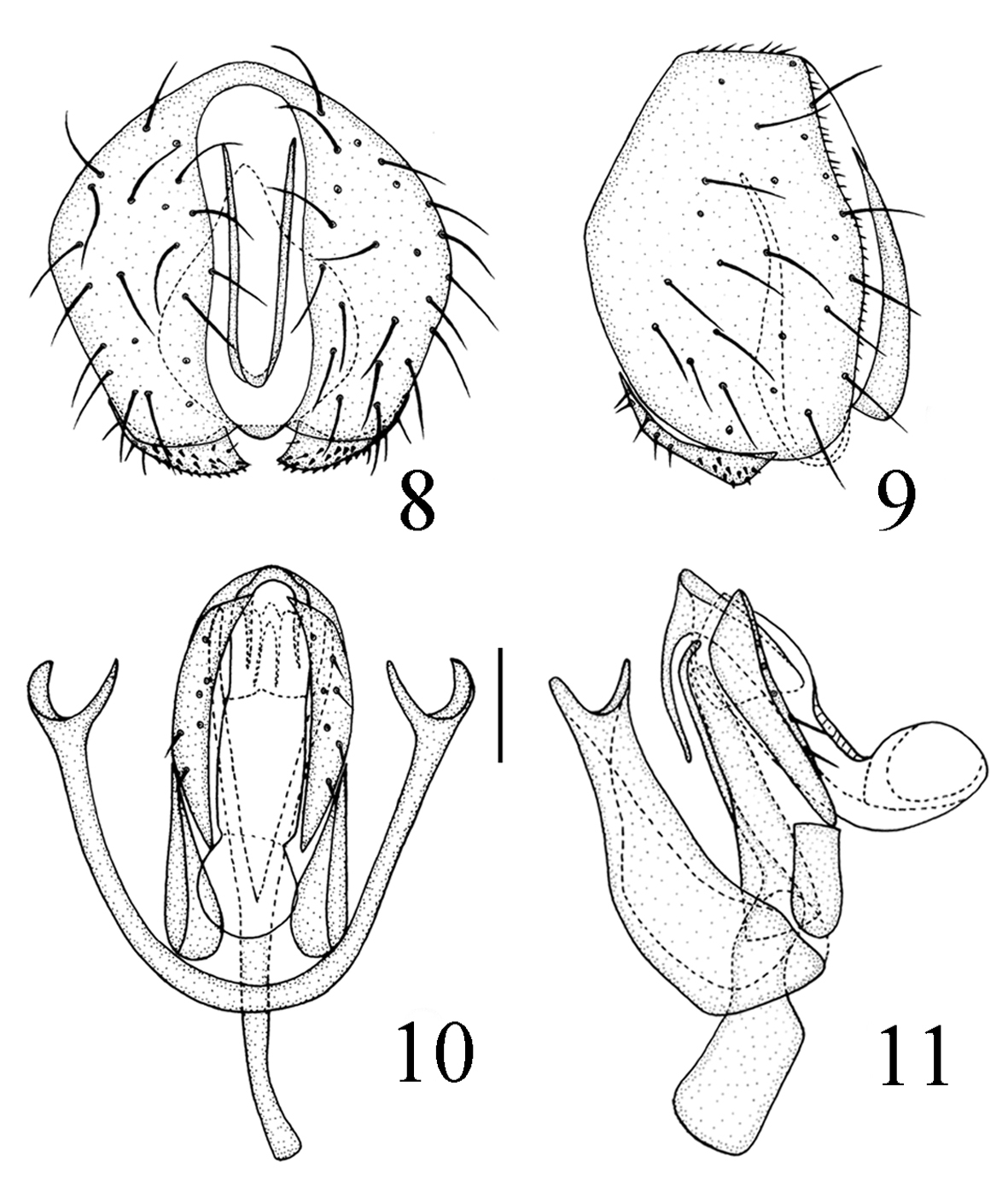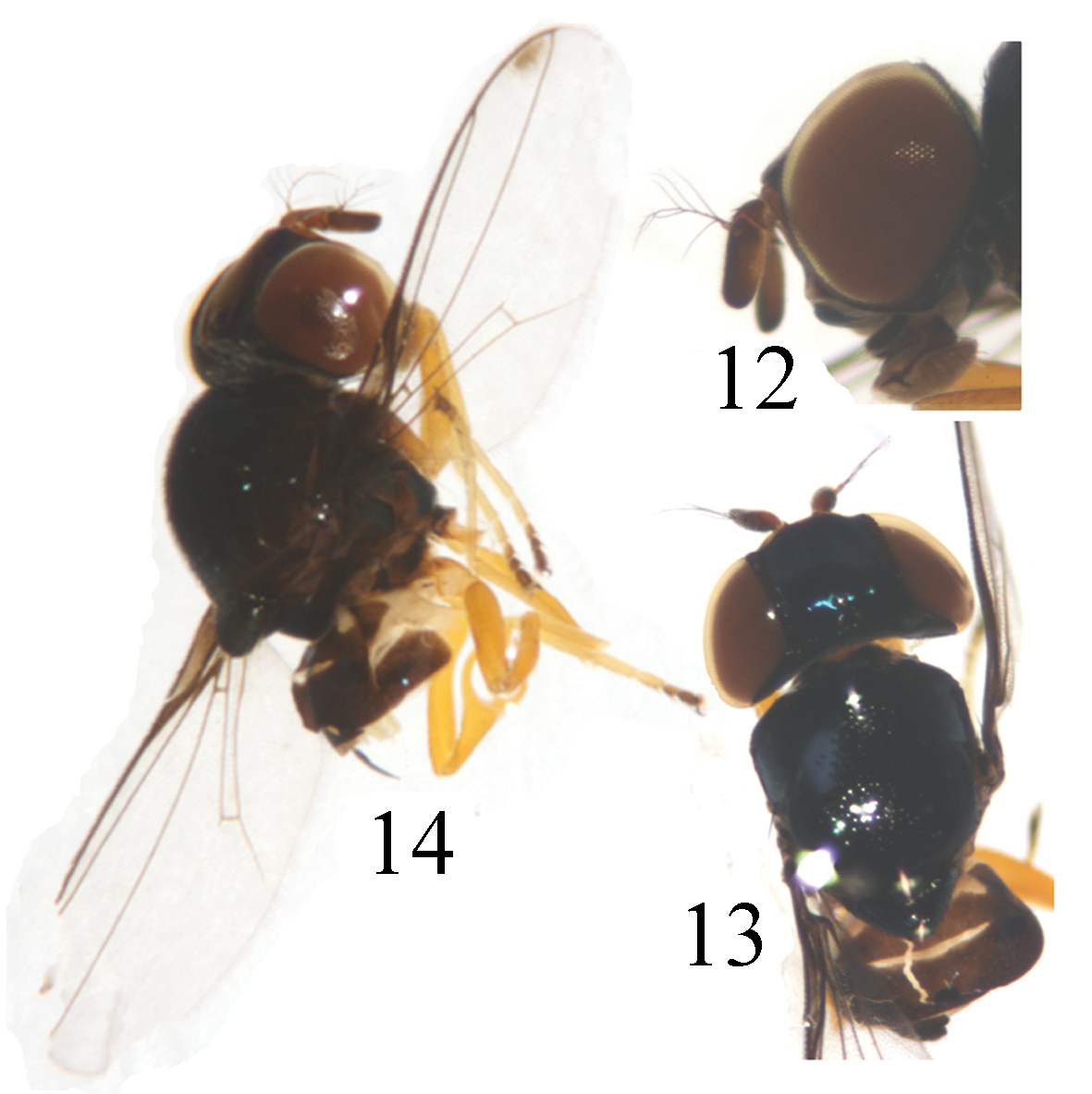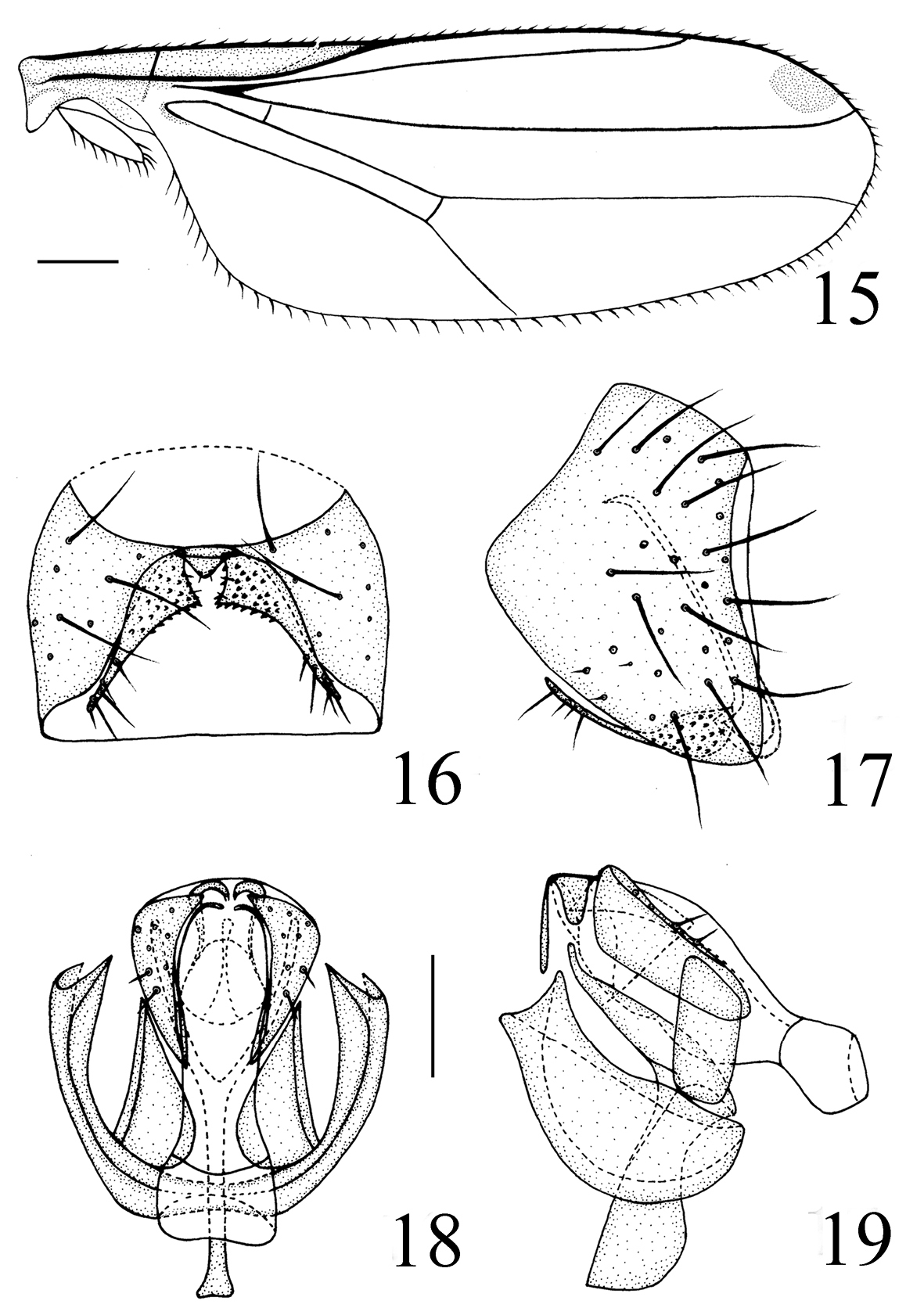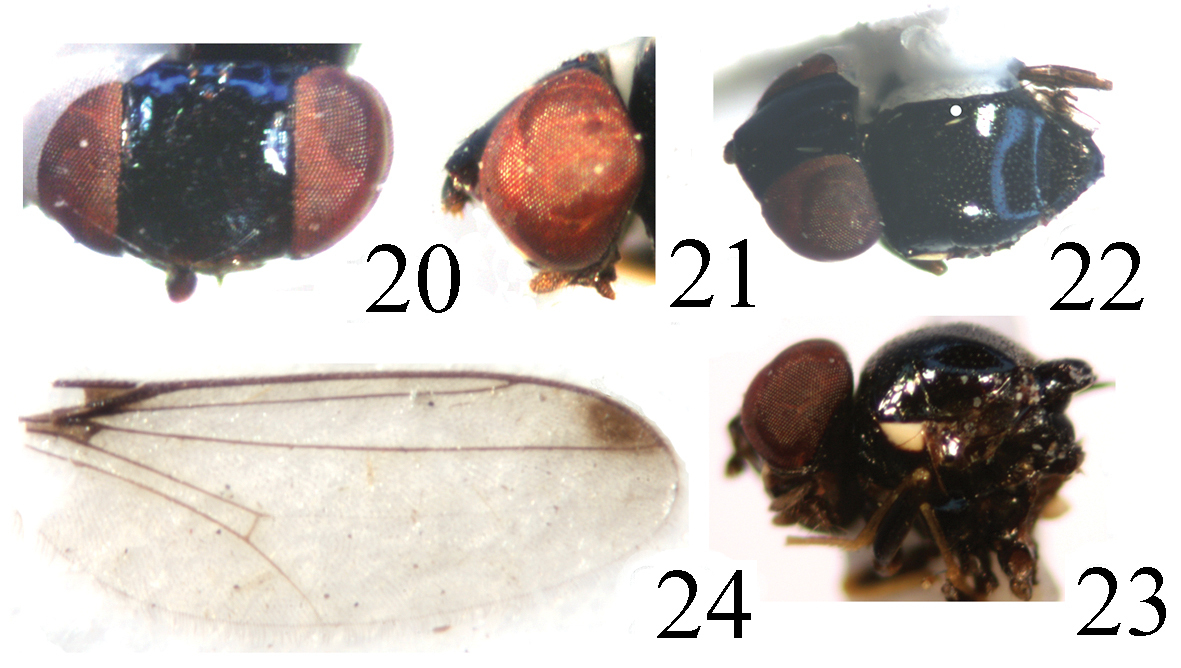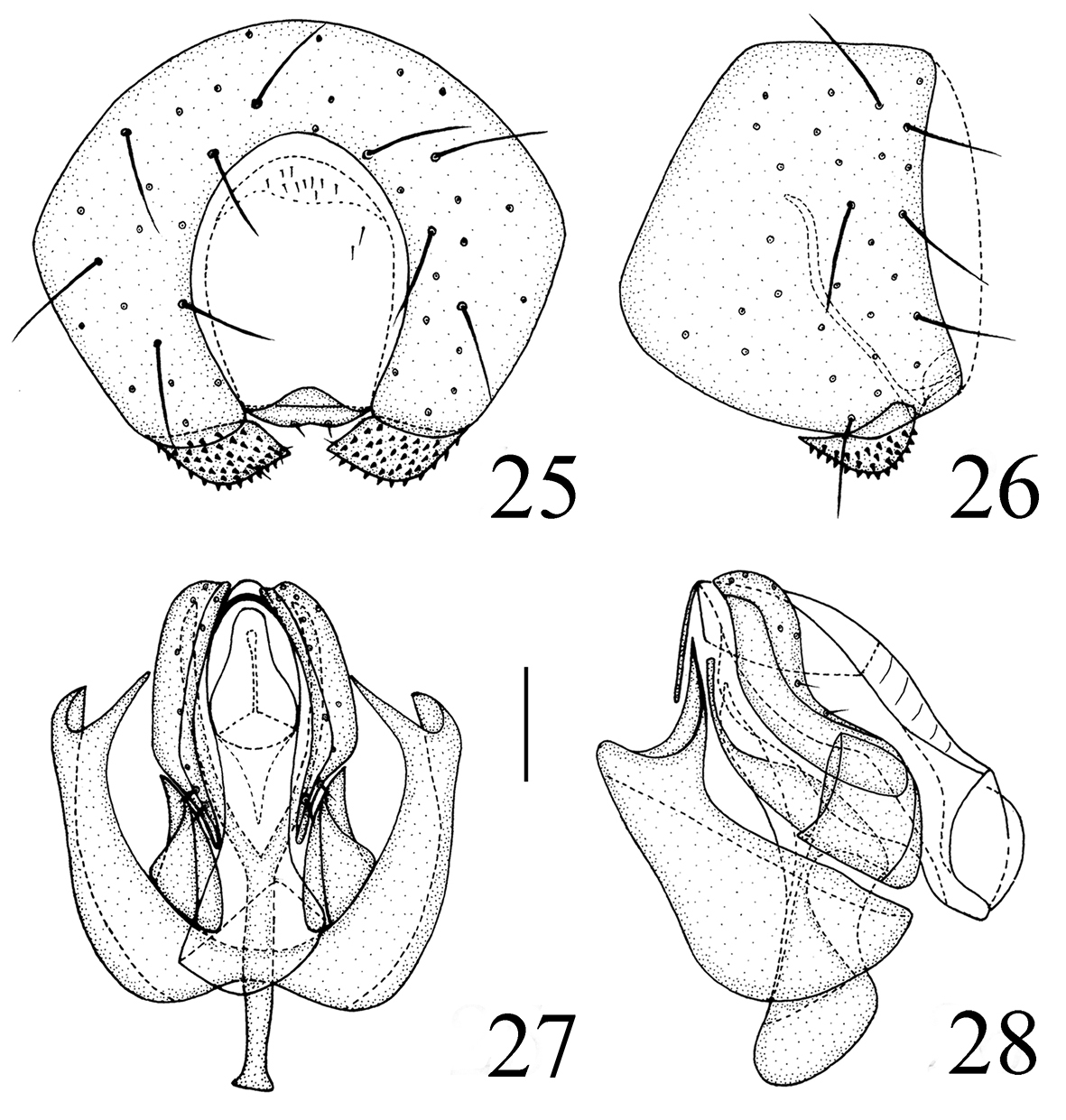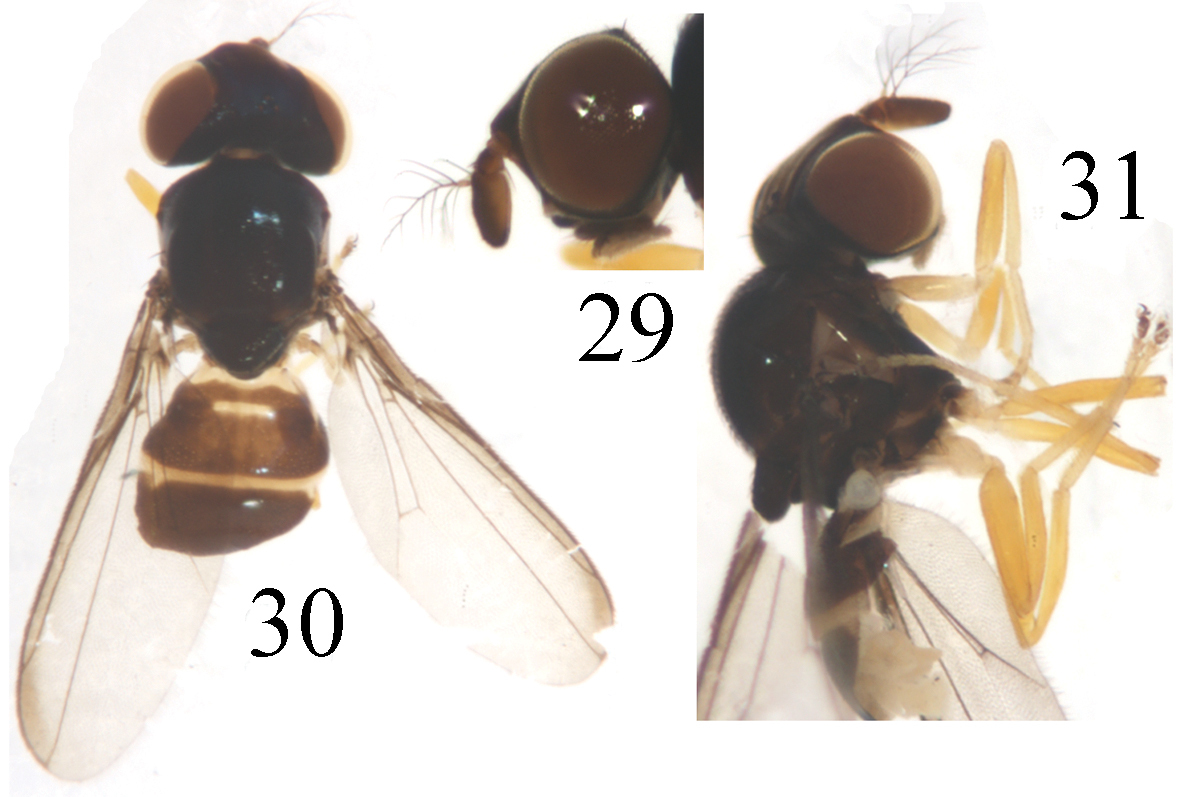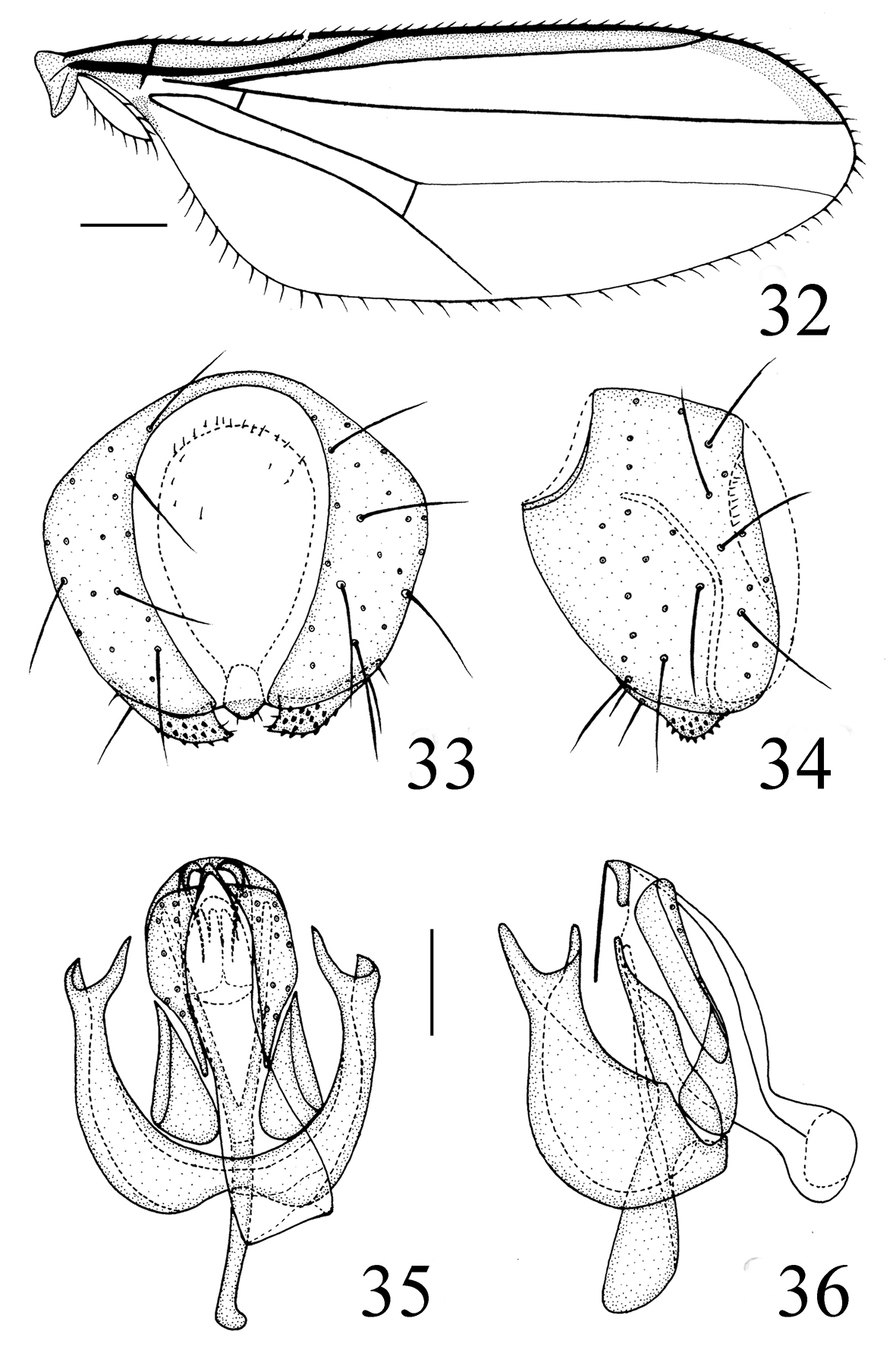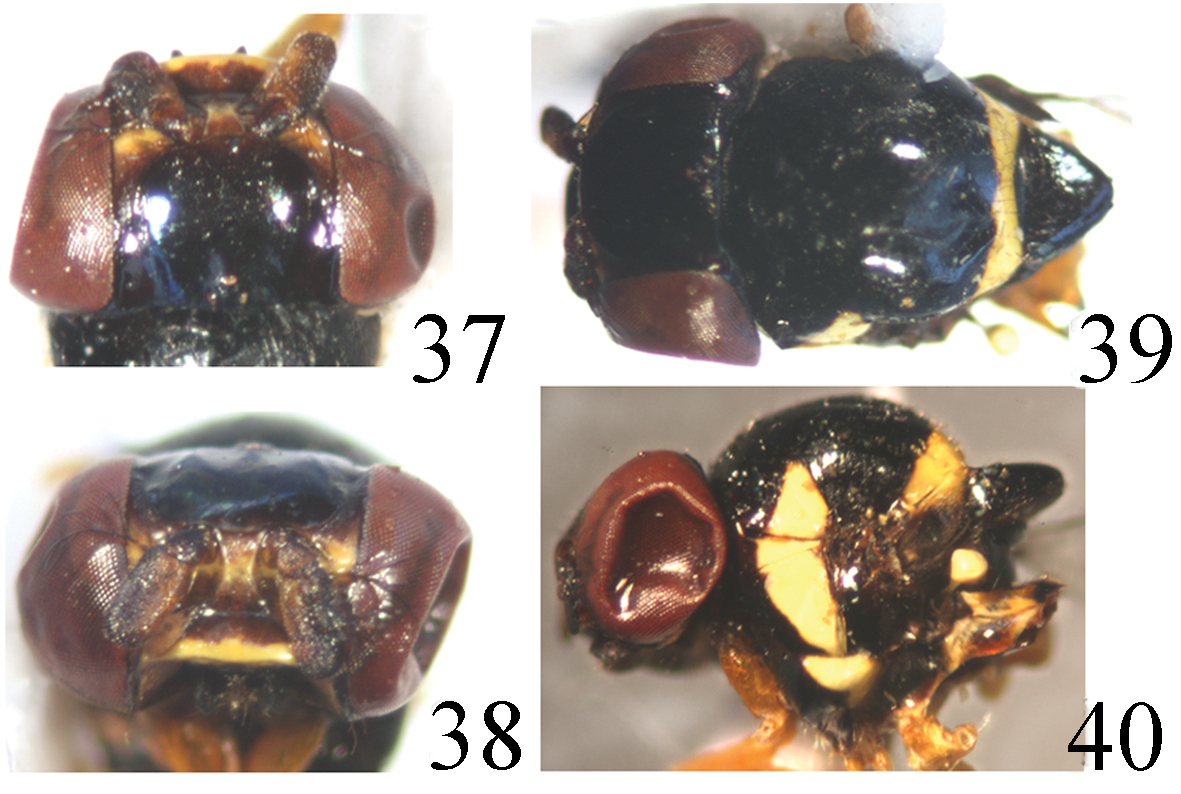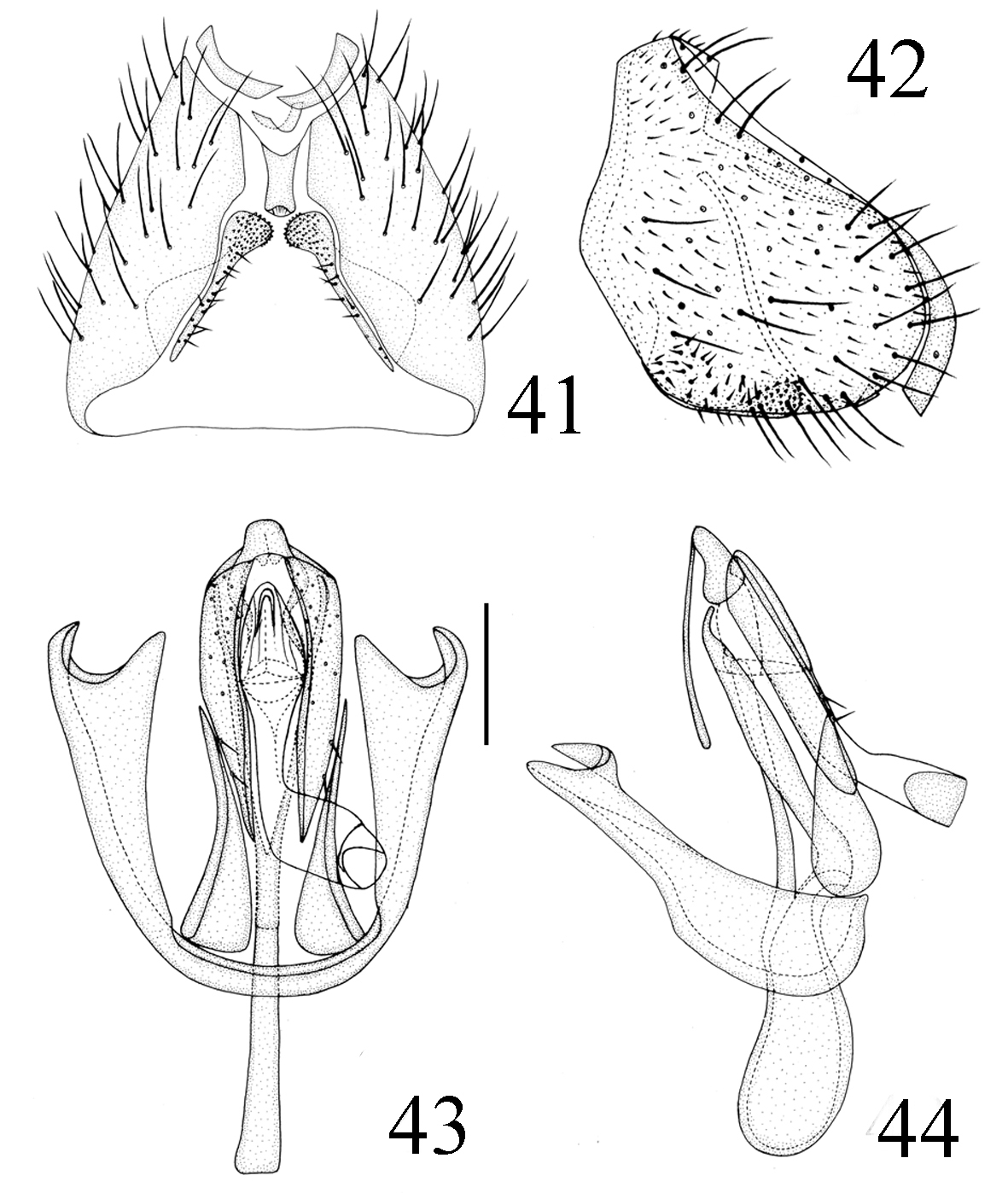






(C) 2011 Xiao-Yan Liu. This is an open access article distributed under the terms of the Creative Commons Attribution License, which permits unrestricted use, distribution, and reproduction in any medium, provided the original author and source are credited.
For reference, use of the paginated PDF or printed version of this article is recommended.
A review of the species of the genus Thressa from China is provided. The following four species are described as new to science: Thressa bimaculata sp. n., Thressa daiyunshana sp. n., Thressa foliacea sp. n. and Thressa longimaculata sp. n. One species, Thressa flavior (Duda), is recorded from China for the first time. A key to the species of the Thressa from China is given.
Diptera, Chloropidae, Thressa, new species, China
The genus Thressa was erected by
Figures 1–2. Thressa guizhouensis Yang, male. 1 body, dorsal view 2 body, lateral view.
Presently, five species are known to occur in China (
Specimens were studied and illustrated with a ZEISS Stemi 2000–c. Genitalic preparations were made by macerating the apical portion of the abdomen in warm 10% NaOH for 17–20 min, after examination it was transferred to fresh glycerine and stored in a microvial pinned below the specimen. Specimens are deposited in the Entomological Museum of China Agricultural University (CAU), Beijing.
The following abbreviations are used:
ap sc apical scutellar seta
oc ocellar seta
orb orbital seta
if interfrontal seta
vti medial vertical seta
vte lateral vertical seta
pvt postvertical seta.
Taxonomy A key to the species of Thressa from China (modified from Nartshuk 1993)| 1 | Wing hyaline, with a brown spot near wing apex | 2 |
| – | Wing hyaline, without a brown spot near wing apex | 6 |
| 2 | Costal cell and marginal cell somewhat tinged with brown | Thressa longimaculata sp. n. |
| – | Only costal cell somewhat tinged with brown | 3 |
| 3 | Abdomen entirely black, shiny | 4 |
| – | Abdomen not entirely black, distal portion with yellow in varying degrees | 5 |
| 4 | Legs yellow, but femora black centrally in female; surstylus basally broad, distally narrowed | Thressa beckeri (de Meijere, 1913) |
| – | Legs black, but distal part of femora, entire tibiae and tarsi yellow; surstylus short, leaf-shaped | Thressa foliacea sp. n. |
| 5 | Legs yellow, except for basal fore coxae, mid coxae black; pregonite about as long as postgonite | Thressa daiyunshana sp. n. |
| – | Legs yellow, except for fore and mid coxae black, fore femora blackish, only distal ends yellow; pregonite shorter than postgonite | Thressa maculata Yang, 1992 |
| 6 | Scutum with yellow spot anterior to scutellum | 7 |
| – | Scutum entirely black, without yellow spot anterior to scutellum | 8 |
| 7 | Scutum with 2 slightly impressed short and shallow depressions on dorsocentral lines, and 2 small yellow spots on both sides of scutum anterior to scutellum | Thressa bimaculata sp. n. |
| – | Scutum without impressed short and shallow depressions on dorsocentral lines, with minutely granulated surface, and a yellow transverse stripe anterior to scutellum | Thressa flavior (Duda, 1934) |
| 8 | Epandrium with a pair of band-like sclerites along posterodorsal notch; cercus with a concavity on ventral margin | Thressa cyanescens (Becker, 1916) |
| – | Epandrium without a pair of band-like sclerites along posterodorsal notch; cercus without a concavity on ventral margin | 9 |
| 9 | Frons slightly longer than wide (33:28); costal cell almost colorless | Thressa spuria (Thomson, 1869) |
| – | Frons about as long as wide; costal cell somewhat tinged with brown | Thressa guizhouensis Yang, 1992 |
urn:lsid:zoobank.org:act:BE223EEF-761E-409D-B4B6-88F7EA931958
http://species-id.net/wiki/Thressa_bimaculata
Figs 3–11Scutum with 2 small yellow spots on both sides anterior to scutellum. Dorsal portion of katepisternum with a small band-like yellow spot. Legs yellow except tarsomere 5 brown. Abdomen black except tergite 5 medially black and laterally yellow.
Male. Body length 2.0 mm, wing length1.8 mm.
Head (Figs 3, 4) black without microtomentum, about 0.75 times as long as high, wider than thorax; face sometimes concave in lateral view, bright brown; epistoma yellow; frons black, about as long as wide, projecting only slightly in front of eye, almost entirely occupied by broad ocellar triangle; gena linear; vibrissal angle obtuse; parafacial black, narrow; postgena black; clypeus light black. Ocellar triangle very large and broad, smooth, black, shiny, reaching to anterior margin of frons with broad apex; ocellar tubercle black. Occiput black. Cephalic setae and setulae black, weakly developed; if extremely short, in 1 row on the surface of the triangle; orb very minute, upright; oc extremely small; pvt small hair-like, upright, convergent; vte shorter than pvt and vti indistinct. Antenna dark brown, with thick grayish microtomentum, but postpedicel missing in holotype. Proboscis and palpus black with blackish setulae.
Thorax (Figs 5, 6) shiny black without microtomentum, evenly covered with short setulae. Scutum strongly convex, almost as long as wide, with 2 slightly impressed short and shallow depressions on dorsocentral lines, and 2 small yellow spots on both sides of scutum anterior to scutellum. Thoracic pleuron darkish brown except for katepimeron and anepimeron with some pale gray microtomentum; dorsal portion of katepisternum with a small band-like yellow spot. Scutellum about 0.7 times as long as wide; ap sc short, distinctly shorter than scutellum. Setae and setulae on thorax black. Legs yellow except tarsomere 5 brown. Setulae on legs yellow, but apical portion of tarsi with some brown setulae. Tibial organ distinct, oblong. Wing (Fig. 7) about 2.7 times as long as wide, hyaline without brown spot near wing apex, costal cell somewhat tinged with brown; veins brown. Relative lengths of 2nd : 3rd : 4th costal sections = 5 : 3 : 1; discal cell narrow and long; crossveins r-m and m-m not approximate, r-m at basal 1/3 of discal cell. Halter pale yellow on knob, brown on stem.
Figures 3–7. Thressa bimaculata sp. n., male. 3 head, dorsal view 4 head, lateral view 5 mesonotum and scutellum, dorsal view 6 mesonotum and scutellum, lateral view 7 wing.
Abdomen shiny black except for tergite 5 medially black and laterally yellow; venter yellow. Setulae on abdomen black. Male genitalia (Figs 8–11): Epandrium short tubular, weakly sclerotized, yellow with yellow long setulae, with 2 band-like sclerites along posterodorsal notch; surstylus basally broad with short spinous setulae, distally narrowed, attached to epandrium anteroventrally. Cercus small, semicircular in dorsal view. Gonites arranged in a row; postgonite slightly incurved distally with pointed apex, with some sensory setulae, basally gradually narrowed; pregonite shorter than postgonite, basally broad and round, distally narrowed; basiphallus longer than wide, cylindrical; distiphallus cylindrical, longer than basiphallus, extended to basal 1/4 of pregonite, largely membranous but weakly sclerotized on apical end; phallapodeme long, extended near base of basiphallus, with basal stalk broad in lateral view. Hypandrium narrow.
Female. Unknown.
Figures 8–11. Thressa bimaculata sp. n., male. 8 epandrium, posterior view 9 epandrium, lateral view 10 hypandrium and phallic complex, ventral view 11 hypandrium and phallic complex, lateral view. Scale bar = 0.05mm.
Holotype ♂, Yunnan: Mengla (21°29'N, 101°33'E, 780m), 9. V. 2009, Guoquan Wang. Male type specimen dry mounted on label laterally on right thorax; postpedicel is missing.
China: Yunnan.
The new species is somewhat similar to Thressa cyanescens
(Becker) in the scutum with the slightly impressed short and shallow
depressions on dorsocentral lines and the abdomen shiny black except
tergite 5 medially black and laterally yellow. But it can be separated
from the latter by the scutum with 2 small yellow spots on both sides
anterior to the scutellum; the dorsal portion of the katepisternum with
one small band-like yellow spot; the cercus semicircular in dorsal view.
In Thressa cyanescens,
the scutum is entirely shiny black; the thoracic pleuron is entirely
shiny black except for the microtomentose katepimeron; the cercus has a
concavity on the ventral margin (
The specific name is from the Latin bi- (“two”) and maculatus (“maculate”), refers to the scutum with 2 small yellow spots.
urn:lsid:zoobank.org:act:5165C077-244C-4F30-8507-BD41FA133F72
http://species-id.net/wiki/Thressa_daiyunshana
Figs 12–19Thoracic pleuron blackish brown except for posterodorsal portion of katepisternum with a triangular yellowish brown spot; anterodorsal portion of katepimeron with a triangular yellow spot. Cercus triangular in ventral view. Pregonite about as long as postgonite.
Male. Body length2.9 mm, wing length2.2 mm.
Head (Fig. 12) black without microtomentum, about 0.8 times as long as high, wider than thorax; face sometimes concave in lateral view, bright brown with a yellow medial stripe more or less on dorsal 1/2; epistoma yellow; frons black, about as long as wide, projecting only slightly in front of eye, almost entirely occupied by broad ocellar triangle; gena narrowed, about 1/10 times as high as postpedicel; vibrissal angle obtuse; parafacial black, linear; postgena black; clypeus light black. Ocellar triangle very large and broad, smooth, black, shiny metallic blue, reaching to anterior margin of frons with broad apex; ocellar tubercle black. Occiput black. Cephalic setae and setulae black, weakly developed; if extremely short, in 1 row on the surface of the triangle; orb very minute, upright; oc subequal to orb; pvt small hair-like, upright, convergent; vte shorter than pvt and vti indistinct. Antenna darkish brown with thick grayish microtomentum, but pedicel with yellow ventral surface, postpedicel yellow at basoventral portion; postpedicel 2 times as long as wide, parallel-sided; arista pectinate, with 5 branches dorsally and 4 ventrally, apically with some short setulae, black except for basal segment yellow. Proboscis yellow with yellowish setulae and palpus black with black setulae.
Thorax (Figs 13, 14) shiny black without microtomentum, with granulated microsculpture, evenly covered with short setulae. Scutum strongly convex, almost as long as wide. Thoracic pleuron blackish brown except for posterodorsal portion of katepisternum with a triangular yellowish brown spot; anterodorsal portion of katepimeron with a triangular yellow spot. Scutellum about 0.5 times as long as wide; ap sc short, distinctly shorter than scutellum. Setae and setulae on thorax black. Legs yellow except for basal fore coxae, mid coxae, tarsomeres 4–5 black. Setulae on legs yellow, but apical portion of tarsi with some brown setulae. Tibial organ distinct, oblong. Wing (Fig. 15) about 2.9 times as long as wide, hyaline with a brown spot near wing apex, costal cell somewhat tinged with brown; veins brown. Relative lengths of 2nd : 3rd : 4th costal sections = 5 : 2.5 : 1; discal cell narrow and long; crossveins r-m and m-m not approximate, r-m at basal 1/3 of discal cell. Halter pale yellow on knob, brown on stem.
Figures 12–14. Thressa daiyunshana sp. n., male. 12 head, lateral view 13 head and thorax, dorsal view 14 head and thorax, lateral view.
Abdomen shiny black except for distal 1/3 of tergite 3 and tergite 4 medially yellow, tergite 5 entirely yellow; venter yellow. Setulae on abdomen brown. Male genitalia (Figs 16–19): Epandrium short tubular, weakly sclerotized, yellow with long yellow setulae; surstylus basally broad with short spinous setulae, distally narrowed, attached to epandrium anteroventrally. Cercus triangular in ventral view. Gonites arranged in a row; postgonite slightly incurved distally with pointed apex, basally gradually narrowed, with some sensory setulae; pregonite about as long as postgonite, basally broad and round, distally narrowed; basiphallus longer than wide, cylindrical; distiphallus cylindrical, longer than basiphallus, beyond lower margin of hypandrium, largely membranous but weakly sclerotized on apex; phallapodeme long, extended near base of basiphallus, with basal stalk broad in lateral view. Hypandrium narrow.
Female. Unknown.
Figures 15–19. Thressa daiyunshana sp. n., male. 15 wing 16 epandrium, ventral view 17 epandrium, lateral view 18 hypandrium and phallic complex, ventral view 19 hypandrium and phallic complex, lateral view. Scale bar = 0.2mm (15), Scale bar = 0.05mm (16–19).
Holotype ♂, Fujian: Dehua, Daiyunshan (25°47'N, 118°15'E, 720m), 11. VII. 2010, Xiaoyan Liu. Male type specimen was stored in 75% ethanol.
China: Fujian.
The new species is somewhat similar to Thressa apicalis
(de Meijere) in the wing with a brown spot near the wing apex and the
abdomen largely yellow. But it can be separated from the latter by the
posterodorsal portion of the katepisternum with a triangular yellowish
brown spot; the anterodorsal portion of the katepimeron with a
triangular yellow spot; the legs yellow except for the basal fore coxae,
mid coxae black. In Thressa apicalis,
the dorsal portion of the katepisternum has one elongated yellow spot;
the legs are yellow except the basal fore coxae black (
The species isnamed after the type locality Daiyunshan.
urn:lsid:zoobank.org:act:692F9739-E69F-414B-9A14-307B16AA53B2
http://species-id.net/wiki/Thressa_foliacea
Figs 20–28Antenna black; postpedicel 2.5 times as long as wide. Thoracic pleuron bright black except katepisternum, anepimeron and katepimeron with some pale gray microtomentum; paratergite and dorsal portion of anepisternum with a trapezoidal, bright yellow spot. Surstylus short, leaf-shaped.
Male.Body length2.3 mm, wing length1.9 mm.
Head (Figs 20, 21) black without microtomentum, about 0.9 times as long as high, wider than thorax; face sometimes concave in lateral view, bright brown with two yellow spots below antenna; epistoma yellow; frons black, 1.1 times as long as wide, projecting only slightly in front of eye, almost entirely occupied by broad ocellar triangle; gena narrow; vibrissal angle obtuse; parafacial black, linear; postgena black; clypeus light black. Ocellar triangle very large and broad, smooth, black, shiny metallic blue, reaching to anterior margin of frons with broad apex; ocellar tubercle black. Occiput black. Cephalic setae and setulae black, weakly developed; if extremely short, in 1 row on the surface of the triangle; orb very minute, upright; oc subequal to orb; pvt small hair-like, upright, convergent; vte shorter than pvt and vti indistinct. Antenna black with thick grayish microtomentum; postpedicel 2.5 times as long as wide, parallel-sided; arista missing in holotype. Proboscis and palpus blackish brown with brownish setulae.
Thorax (Figs 22, 23) shiny black without microtomentum, with granulated microsculpture, evenly covered with short setulae. Scutum strongly convex, almost as long as wide. Thoracic pleuron bright black except for katepisternum, anepimeron and katepimeron with some pale gray microtomentum; paratergite and dorsal portion of anepisternum with a trapezoidal, bright yellow spot. Scutellum about 0.5 times as long as wide; ap sc short, distinctly shorter than scutellum. Setae and setulae on thorax black. Legs black except for distal part of femora, entire tibiae and tarsi yellow. Setulae on legs yellow, but apical portion of tarsi with some brown setulae. Tibial organ distinct, oblong. Wing (Fig. 24) about 2.9 times as long as wide, hyaline with a brown spot near wing apex, costal cell somewhat tinged with brown; veins brown. Relative lengths of 2nd : 3rd : 4th costal sections = 5 : 2.5 : 1; discal cell narrow and long; crossveins r-m and m-m not approximate, r-m at basal 1/3 of discal cell. Halter pale yellow on knob, brown on stem.
Figures 20–24. Thressa foliacea sp. n., male. 20 head, dorsal view 21 head, lateral view 22 mesonotum and scutellum, dorsal view 23 mesonotum and scutellum, lateral view 24 wing.
Abdomen shiny black; venter yellow. Setulae on abdomen black. Male genitalia (Figs 25–28): Epandrium short tubular, weakly sclerotized, black with long black setulae; surstylus short, leaf-shaped with short spinous setulae. Cercus with a concavity on ventral margin. Gonites arranged in a row; postgonite slightly incurved distally with blunt apex, basal 1/4 obviously narrowed, with some sensory setulae; pregonite shorter, about 0.5 times as long as postgonite, basally broad, distally narrowed; basiphallus longer than wide, cylindrical; distiphallus cylindrical, longer than basiphallus, beyond lower margin of hypandrium, largely membranous but weakly sclerotized on apical end; phallapodeme long, extended near base of basiphallus, with basal stalk short and broad in lateral view. Hypandrium broad.
Female. Unknown.
Figures 25–28. Thressa foliacea sp. n., male. 25 epandrium, posterior view 26 epandrium, lateral view 27 hypandrium and phallic complex, ventral view 28 hypandrium and phallic complex, lateral view. Scale bar = 0.05mm.
Holotype ♂, Hainan: Baisha (19°11'N, 109°25'E, 430m), 19. X. 2007, Xingyue Liu. Male type specimen dry mounted on label laterally on right thorax; arista is missing.
China: Hainan.
The new species is somewhat similar to Thressa punctifera
(de Meijere) in the wing with a brown spot near the wing apex and the
abdomen shiny black. But it can be separated from the latter by the
paratergite and dorsal portion of the anepisternum with one trapezoidal,
bright yellow spot; the legs black except for the distal part of
femora, entire tibiae and tarsi yellow; the surstylus short,
leaf-shaped. In Thressa punctifera,
the katepisternum has one narrow yellow spot; the legs are yellow
except for the fore femora brownish; the surstylus is broad basally and
narrow distally (
The specific name is from the Latin foliaceus (“leaf-shaped”), refers to the leaf-shaped surstylus.
urn:lsid:zoobank.org:act:39D8C4B4-1E6F-486F-BE05-BAD2A3B96F40
http://species-id.net/wiki/Thressa_longimaculata
Figs 29–36Thoracic pleuron brown except for katepisternum and katepimeron with black lower portion; paratergite and posterodorsal portion of anepisternum with a triangular yellow spot. Wing hyaline with a long brown spot near wing apex, costal cell and marginal cell somewhat tinged with brown. Cercus semicircular in dorsal view. Postgonite with basal 1/3 obviously narrowed.
Male. Body length 2.6 mm, wing length 2.0 mm
Head (Fig. 29) black without microtomentum, about 0.85 times as long as high, wider than thorax; face sometimes concave in lateral view, bright brown with a yellow medial stripe more or less on dorsal 1/2; epistoma yellow; frons black, about as long as wide, projecting only slightly in front of eye, almost entirely occupied by broad ocellar triangle; gena narrow, about 1/10 times as high as postpedicel; vibrissal angle obtuse; parafacial black, linear; postgena black; clypeus light black. Ocellar triangle very large and broad, smooth, black, shiny metallic blue, reaching to anterior margin of frons with broad apex; ocellar tubercle black. Occiput black. Cephalic setae and setulae black, weakly developed; if extremely short, in 1 row on the surface of the triangle; orb very minute, upright; oc extremely small; pvt small hair-like, upright, convergent; vte short than pvt and vti indistinct. Antenna darkish brown with thick grayish microtomentum, but pedicel with yellow ventral surface, postpedicel yellow at basoventral portion; postpedicel 2 times as long as wide, parallel-sided; arista pectinate, with 5 branches dorsally and 4 ventrally, apically with some short setulae, black except for basal segment yellow. Proboscis yellow with yellowish setulae and palpus black with black setulae.
Thorax (Figs 30, 31) shiny black without microtomentum, with granulated microsculpture, evenly covered with short setulae. Scutum strongly convex, almost as long as wide. Thoracic pleuron brown except for katepisternum and katepimeron with black lower portion; paratergite and posterodorsal portion of anepisternum with a triangular yellow spot. Scutellum about 0.5 times as long as wide; ap sc short, distinctly shorter than scutellum. Setae and setulae on thorax black. Legs yellow except for basal portion of mid coxae, tarsomere 5 brown. Setulae on legs yellow, but apical portion of tarsi with some brown setulae. Tibial organ distinct, oblong. Wing (Fig. 32) about 3.1 times as long as wide, hyaline with a brown spot near wing apex, costal cell and marginal cell somewhat tinged with brown; veins brown. Relative lengths of 2nd : 3rd : 4th costal sections = 5 : 2.5 : 1; discal cell narrow and long; crossveins r-m and m-m not approximate, r-m at basal 1/3 of discal cell. Halter pale yellow on knob, brown on stem.
Figures 29–31. Thressa longimaculata sp. n., male. 29 head, lateral view 30 head and thorax, dorsal view 31 head and thorax, lateral view.
Abdomen shiny blackish brown except tergite 5 yellow with a M-shaped black spot; venter yellow. Setulae on abdomen brown. Male genitalia (Figs 33–36): Epandrium short tubular, weakly sclerotized, yellow with long yellow setulae; surstylus basally broad with short spinous setulae, distally narrowed, attaching to epandrium anteroventrally. Cercus semicircular in dorsal view. Gonites arranged in a row; postgonite gradually narrowed distad and slightly convergent, basal 1/3 obviously narrowed, with sensory setulae; pregonite shorter than postgonite, basally broad and round, distally narrowed; basiphallus longer than wide, cylindrical; distiphallus cylindrical, longer than basiphallus, beyond lower margin of hypandrium, largely membranous but weakly sclerotized on apical end; phallapodeme long, extended near base of basiphallus, with basal stalk broad in lateral view. Hypandrium narrow.
Female. Unknown.
Figures 32–36. Thressa longimaculata sp. n., male. 32 wing 33 epandrium, posterior view 34 epandrium, lateral view 35 hypandrium and phallic complex, ventral view 36 hypandrium and phallic complex, lateral view. Scale bar = 0.2mm (32), Scale bar = 0.05mm (33–36).
Holotype ♂, Fujian: Wuyishan (26°54'N, 116°42'E, 850m), 17. VII. 2010, Xiaoyan Liu. Male type specimen was stored in 75% ethanol.
China: Fujian.
The new species is somewhat similar to Thressa signifera
Walker in the wing with a brown spot near the wing apex, costal cell
and marginal cell somewhat tinged with brown. But it can be separated
from the latter by the katepisternum and katepimeron with the black
lower portion; the paratergite and posterodorsal portion of the
anepisternum with one triangular yellow spot; the femora entirely
yellow. In Thressa signifera, the thoracic pleuron has a white band; the femora are black except yellow distally (
The specific name is from the Latin longi- (“long”) and maculatus (“maculate”), refers to the long brown spot near the wing tip.
http://species-id.net/wiki/Thressa_flavior
Figs 37– 44Scutum with a yellow transverse stripe anterior to scutellum, about 1/7 times as long as scutum. Paratergite and anepisternum with one oblique, wide, yellow stripe; dorsal portion of katepisternum with a small triangular yellow spot. Surstylus pipe-like. Cercus long, oblong in dorsal view.
Male.Body length3.0–3.5 mm, wing length2.4–2.9 mm.
Head (Figs 37, 38) black without microtomentum, about 0.8 times as long as high, wider than thorax; face sometimes concave in lateral view, bright brown with a yellow transverse stripe below antenna; epistoma yellow; frons black except for anterior 1/8 yellow, about 0.75 times as long as wide, projecting only slightly in front of eye, almost entirely occupied by broad ocellar triangle; gena black, narrow, about 1/10 times as high as postpedicel; vibrissal angle obtuse; parafacial black, linear; postgena black; clypeus light black. Ocellar triangle very large and broad, shiny black, smooth, reaching to anterior margin of frons with broad apex; ocellar tubercle black. Occiput black. Cephalic setae and setulae black, weakly developed; if extremely short, in 1 row on the surface of the triangle; orb very minute, upright; oc extremely small; pvt small hair-like, upright, convergent; vte shorter than pvt and vti indistinct. Antenna black with thick grayish microtomentum, but postpedicel with yellowish brown ventral surface; postpedicel 2 times as long as wide, parallel-sided; arista pectinate with 4 branches dorsally and 3 ventrally, apically with some short setulae, black except for basal segment yellow. Proboscis and palpus light blackish brown with blackish setulae.
Thorax (Figs 39, 40) black without microtomentum, with granulated microsculpture, evenly covered with short setulae. Scutum strongly convex, almost as long as wide, with a yellow transverse stripe anterior to scutellum, about 1/7 times as long as scutum. Thoracic pleuron black except for paratergite and anepisternum with one oblique, wide, yellow stripe; dorsal portion of katepisternum with a small triangular yellow spot. Scutellum about 0.7 times as long as wide; ap sc short, distinctly shorter than scutellum. Setae and setulae on thorax black. Legs yellow except for tarsomere 5 brown. Setulae on legs yellow, but apical portion of tarsi with some brown setulae. Tibial organ distinct, oblong. Wing about 2.7 times as long as wide, hyaline without brown spot near wing apex, costal cell somewhat tinged with brown; veins brown. Relative lengths of 2nd: 3rd: 4th costal sections = 5: 2: 1; discal cell narrow and long; crossveins r-m and m-m not approximate, r-m at basal 0.4 of discal cell. Halter pale yellow on knob, brown on stem.
Figures 37–40. Thressa flavior (Duda), male. 37 head, dorsal view 38 head, facial view 39 mesonotum and scutellum, dorsal view 40 mesonotum and scutellum, lateral view.
Abdomen mainly yellow, tergite 2 posteriorly with two narrow black lateral stripes, basal 1/2 of tergite 3 with a transverse black stripe, rest of tergite 3 and following tergites with a mid-longitudinal black stripe; venter yellow. Setulae on abdomen black. Male genitalia (Figs 41–44): Epandrium short tubular, weakly sclerotized, yellow with long yellow setulae, with 2 band-like sclerites along posterodorsal notch; surstylus pipe-like, basally broad with short spinous setulae, distally narrowed, attaching to epandrium anteroventrally. Cercus long, oblong in ventral view. Gonites arranged in a row; postgonite long with some sensory setulae; pregonite slightly shorter than postgonite, basally broad, distally narrowed; basiphallus longer than wide, cylindrical; distiphallus cylindrical, longer than basiphallus, reaching to dorsal margin of hypandrium, largely membranous but weakly sclerotized on apical end; phallapodeme long, extended near base of basiphallus, with basal stalk broad in lateral view. Hypandrium narrow.
Female. Unknown.
Figures 41–44. Thressa flavior (Duda), male. 41 epandrium, ventral view 42 epandrium, lateral view 43 hypandrium and phallic complex, ventral view 44 hypandrium and phallic complex, lateral view. Scale bar = 0.1mm.
Holotype ♂, Sumatra, 1924, E. Jacobson; 1 ♂, Yunnan: Menglun (21°55'N, 101°13'E, 630m), 10. III. 1999, Ding Yang; 1 ♂, Hainan: Wuzhishan (18°50'N, 109°42'E, 600m), 16. V. 2007, Kuiyan Zhang. Type specimen pinned thoracic pleuron, other specimens dry mounted on label laterally on right thorax.
China: Yunnan, Hainan; Indonesia; Malaysia.
The species is somewhat similar to Thressa polita
(de Meijere) in the scutum with a yellow transverse stripe anterior to
the scutellum. But it can be separated from the latter by the abdomen
being mainly yellow, tergite 2 posteriorly with two narrow black
lateral stripes, basal 1/2 of tergite 3 with a transverse black stripe,
rest of tergite 3 and following tergites with a mid-longitudinal black
stripe; the legs entirely yellow. In Thressa polita,
the abdomen is mostly black except for the basal portion and posterior
margin yellow; the legs are yellow except the femora partly black (
http://species-id.net/wiki/Thressa_beckeri
Postpedicel narrow and elongate, 3 times longer than wide.Legs yellow, but entire femora yellow in male; black centrally in female. Wing hyaline with a brown spot near wing apex. Abdomen entirely dark, bluish black.
China: Taiwan; Indonesia; Philippines; Australia.
http://species-id.net/wiki/Thressa_cyanescens
Thorax entirely shiny black. Legs yellow except fore coxae black, in male fore femora black except distal part yellow; in female, all femora black except distal part yellow. Wing hyaline without a brown spot near wing apex. Epandrium with 2 narrow bands of sclerite along posterodorsal notch. Cercus small with a concavity on ventral margin.
China: Taiwan; Japan.
http://species-id.net/wiki/Thressa_spuria
Frons slightly longer than wide (33:28). Femora black, tibiae and tarsi entirely yellow. Wing hyaline without a brown spot near wing apex. Surstylus short, nearly triangular. Pregonite as long as postgonite.
China; Pakistan.
http://species-id.net/wiki/Thressa_guizhouensis
Legs black except for distal part of femora, entire tibiae and tarsi yellow. Wing hyaline without a brown spot near wing apex. Abdomen shiny black. Surstylus short, triangular. Pregonite about 0.7 times as long as postgonite.
Holotype ♂, Allotype ♀, Guizhou: Guiyang, 25. VII. 1987, Jikun Yang; 2 ♂♂, Fujian: Wuyishan, 2. VII. 2009, Li Shi; 6 ♀♀, 3 ♂♂, Fujian: Nanping, 18. VII. 2009, Xiaoyan Liu; 1♂, 1♀, Fujian: Wuyishan, 27. IX. 2009, Weina Cui; 2 ♂♂, Fujian: Wuyishan, 30. IX. 2009, Tingting Zhang; 3 ♂♂, 2 ♀♀, Fujian: Wuyishan, 18. VII. 2010, Xiaoyan Liu; 8 ♂♂, 3 ♀♀, Fujian: Wuyishan, 21–23. VII. 2010, Xiaoyan Liu.
China: Guizhou, Fujian.
http://species-id.net/wiki/Thressa_maculata
Leg yellow, except for fore and mid coxae black, fore femora blackish with yellow distally. Wing hyaline with a brown spot near wing apex. Abdomen shiny yellow except tergites 1–3 black. Surstylus short, incurved distally. Pregonite shorter, about 0.3 times as long as postgonite.
Holotype ♂, Yunnan: Jinghong, 12. IV. 1981, Fasheng Li.
China: Yunnan.
We are grateful to Dr. Xingyue Liu, Dr. Kuiyan Zhang, Dr. Li Shi, Ms. Weina Cui (Beijing) and Dr. Guoquan Wang (Nanning) for collecting the specimens. We thank Dr. Joachim Ziegler (Berlin) for loan of type and Dr. Yngve Brodin (Stockholm) for providing photos of type. Two anonymous reviewers are thanked for providing useful comments on an earlier draft of this paper. Author Xiaoyan Liu expresses her sincere thanks to Dr. Gang Yao, Dr. Shan Huo, Dr. Qifei Liu (Beijing) and Mr. Jinjing Wang (Ontario) for their kind help during the study.
